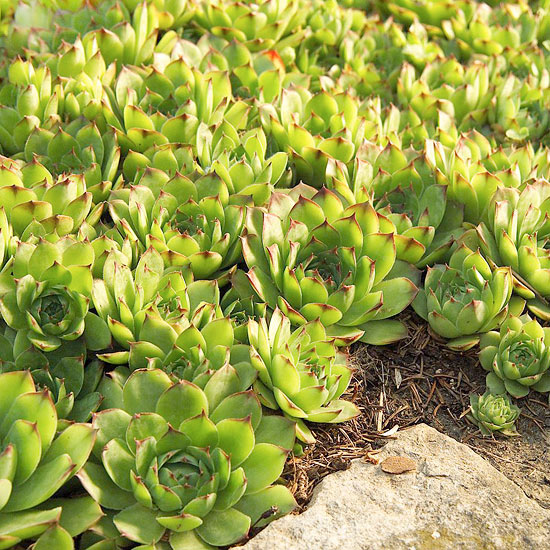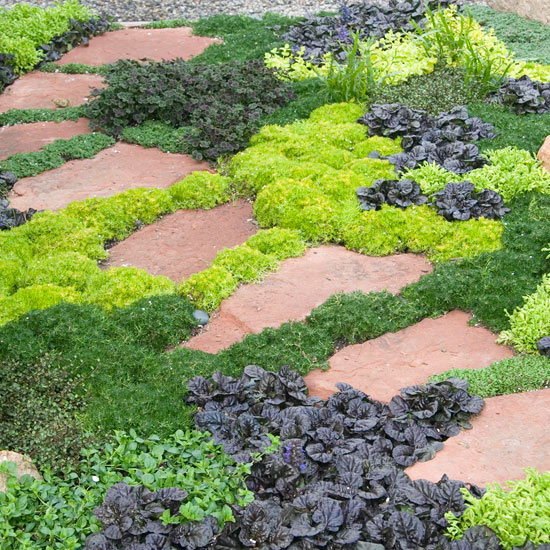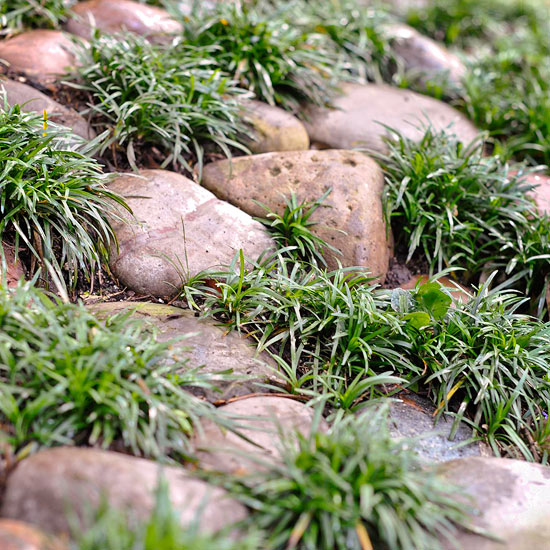





When you feel like tossing a rug over your yard and calling it good, count on groundcover plants. These dependable, hardworking plants carpet the ground with minimal fuss. Sure, you still need to water, weed, and feed them, but they're quick-fix solutions for many landscape problems.
You can find groundcovers that control erosion, blanket a hillside, or thrive in dry conditions while still complementing your home and garden. Some are evergreen, while others lose their foliage in winter. A few groundcovers tolerate foot traffic. After all, turfgrass is a groundcover!
continue reading below
If it's dry, it's time for thyme. This aromatic groundcover or upright plant excels in beds, borders, and containers. The woody-stem plant features tiny, fragrant leaves and flowers that can be used fresh or dried. Creeping varieties can handle moderate foot traffic. Tuck plants between the stepping-stones of a garden path. Plant thyme in full sun and well-drained soil. Zones 5-9
Learn more about thyme.
Find great ideas for stepping-stone paths.
You may already grow tall sedums. But did you know many wonderful creeping types form dense mats only 3 inches tall? With succulent leaves and stems, sedums can thrive in low-water situations, and they bloom in shades of white, pink, red, purple, yellow, or orange, depending on the variety. Sedums are prized for use in green roofs and living walls because they are so adaptable. They perform best in full sun or partial shade and well-drained soil. Zones 3-10
Learn more about sedums.
Hens-and-chicks, an old-fashioned favorite, makes a terrific groundcover in tight spaces, such as between paving stones or in a trough. The plant is also a beautiful textured focal point in a sunny garden. The succulent rosettes grow 3-6 inches tall. They're easy to grow, and need almost no maintenance. Zones 4-8
Learn morea bout hens-and-chicks.
Explore other plants for trough gardens.

Sweet woodruff is one of those rare plants that flourishes in dense shade. Plant it below trees and shrubs where its tiny white spring flowers will bloom about the same time as crabapples. Reaching 6-12 inches tall, sweet woodruff (Galium odoratum) behaves nicely, forming well-behaved clumps of deciduous green foliage on upright stems. Zones 4-8
If you want a groundcover plant with a fast, aggressive spread, bishop's weed is right for you. Use it on shaded or partially shaded slopes or in large woodland areas where it can take over and have the run of the space. It also works well in contained areas, such as between a building and a sidewalk. Choose the variegated variety, considered slightly slower-growing, to add brightness to the shade. Bishop's weed reaches about a foot tall and drops its leaves in winter. Zones 4-9
Learn more about bishop's weed.
Check out tips for taming a slope.
It's pretty, spreads easily, and is easy to keep under control. Try one of the many varieties of ajuga where grass won't easily grow. It can take a bit of foot traffic, but avoid growing it in areas with a lot of activity. Flower spikes in blue, pink, lavender, or white adorn the rosettes formed from scallop-shape leaves in spring. Grow this tidy groundcover plant for its pretty leaves, which come in shades of green, maroon, bronze, purple, pink, or white. Depending on the variety, the foliage can reach 4-9 inches tall. Zones 3-9
Learn more about ajuga.
Lamium, with its silver-marked foliage, brightens a shady corner. This groundcover plant reaches 6-8 inches tall but spreads twice as wide. Use it as a bright decorative highlight next to plants with darker foliage, such as boxwoods and conifers. Place lamium where you won't be smashing it underfoot. Zones 3-8
Learn more about lamium.
Incorporate groundcover plants in shade garden designs.

As tough as its common name, brass buttons (Leptinella squalida 'Platt's Black') grows no taller than 3 inches with textured, feathery foliage in shades of bronze-black to purple-gray and small, buttonlike yellow-green blooms in late spring and early summer. This versatile New Zealand groundcover plant grows in full sun to partial shade and moist but well-drained soil. Zones 5-9
Mondo grass isn't really a grass, but it looks like one. Its slender, strappy, sometimes variegated leaves in shades of green to almost black grow 3-24 inches tall, depending on the variety. Grow it in full to part sun, in rich, moist soil for best results. It's great used as an edging for borders, sidewalks, or driveways. Zones 6-10
Learn more about mondo grass.
Their fuzzy, oh-so-touchable leaves give lamb's-ears their common name. This perennial loves sun or partial shade where its silvery-green leaves can sprawl. It reaches 6-36 inches, depending on the variety. Flower stalks with tiny white, pink, purple, violet, or red blooms are produced in summer, but feel free to cut them off so the leaves continue to be the stars of the show. In hot climates, the leaves may appear to melt away, but they'll revive with cooler weather. In wintry regions, clip old leaves and stalks in spring to promote more growth. Zones 4-9
Learn more about lamb's ears.
See more easy groundcover plants.
Get free charts of sun- and shade-loving groundcovers.
Copyright © www.100flowers.win Botanic Garden All Rights Reserved